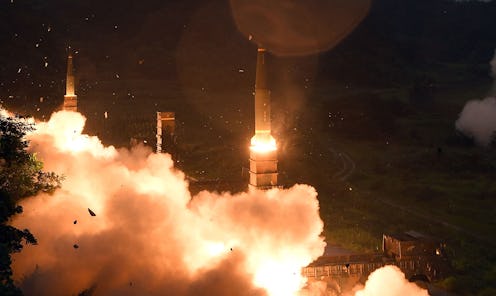News
The U.S. Has A Missile Defense System, But It's Not Totally Reliable

Tensions between the United States and North Korea have risen dramatically in recent weeks, with North Korean leader Kim Jong-un threatening to nuke the island of Guam and President Trump pledging that any more threats "will be met with fire and fury like the world has never seen." Given that North Korea possesses nuclear weapons, this has brought increased attention to the United State's missile defense system, and whether it has the ability to protect America from a nuclear strikes.
Although there are several missile defense systems in the United States, the pertinent one here is Ground-based Midcourse Defense (GMD), the only such system devoted to stopping long-range ballistic missile attacks. GMD is a network of sensors, missile interceptors, and control systems spread across the globe. In theory, it has the capacity to neutralize a nuclear strike.
There are a lot of caveats to this, however. First and foremost, it's not at all clear yet that GMD would be capable of fulfilling its purpose if, heaven forbid, a nuclear strike was launched against America. That's because, although the system has been tested, it hasn't performed particularly well in those dry runs. The military has tested the deployment of GMD 18 times since 1999, and the system has "passed" either nine or 10* of those tests. That's a success ratio of around 50 percent; needless to say, it'd be preferable to have a much higher degree of confidence in a system meant to prevent nuclear war.
But even this might be overstating the missile system's reliability. The test runs gave the missile system something of an unfair advantage, because the GMD operators knew far in advance when the dummy missiles would be launched and could thus prepare accordingly. Obviously, that probably wouldn't be the case in the event of a real-life nuclear attack, so even the GMD's 50 percent success ratio might be artificially inflated.
"In its current form, strategic missile defense is a waste of resources at best and dangerous at worst," the Union of Concerned Scientists wrote in 2016. "It is not a reliable defense under real-world conditions; by promoting it as a solution to nuclear conflict, US officials complicate diplomatic efforts abroad, and perpetuate a false sense of security that could harm the US public."
But Air Force Lt. Gen. Samuel Greaves, director of the Missile Defense Agency, disagrees. When asked at a recent symposium whether America's missile defenses could take out a nuclear-tipped rocket from North Korea, Greaves said, "Yes, we believe that the currently deployed ballistic missile defense system can meet today’s threat."
Lastly, it's worth noting that GMD is only intended to stop a limited nuclear attack — the kind that might come from North Korea, Iran, or any other country with a limited nuclear arsenal. According to the Pentagon, it's not intended to thwart a hypothetical nuclear attack from, say, Russia or China, and wouldn't be capable of doing so.
While trading barbs with Kim, Trump falsely claimed on Twitter that his "first order as President was to renovate and modernize our nuclear arsenal," and that America's nuclear capabilities are "now far stronger and more powerful than ever before." However, Trump has not made any changes to America's nuclear arsenal; that's Congress's job, and Congress hasn't passed any nuclear modernization legislation since Trump took office.
*There's dispute within the Defense Department over whether a 2006 test counts as a success or not, because although it delivered a "glancing blow" to the dummy missile, it didn't destroy it. The Pentagon's director of Operational Test and Evaluation told Congress that he considered the test "a hit but not a kill."